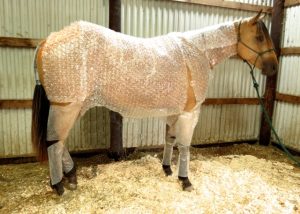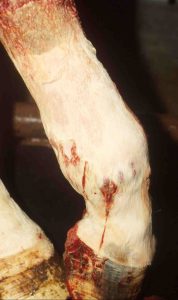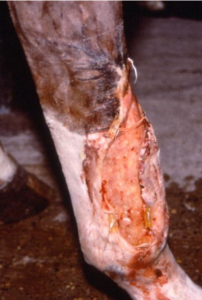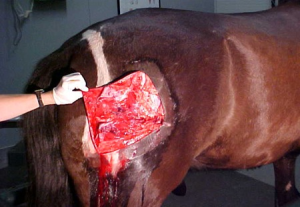Large animal wounds
Wound management overview
Wound evaluation overview – podcast (8 min)
Approximately 20% of after hours equine visits in the UK were due to wounds. Horses are accident prone and there is not much owners can do to prevent injury. [However, shipping boots and horse helmets do probably help more than bubble wrap.]

The most common horse wounds are limb degloving injuries (the horse kicks through something and the skin is pulled away as the limb is pulled back through the glass/wood/metal) and puncture wounds.
Puncture wounds are easy to miss and can immediately penetrate deeper structures and lead to life threatening infection. Owners may consider them unimportant and not call you.

Degloving injuries can readily traumatize joints, bones, tendons, ligaments and vessels due to the limited soft tissue covering of horse limbs. Skin injury can prolong healing for months. Many of these injuries are manageable but require extensive time and money. Giving clients appropriate information from the beginning helps everyone fully understand the treatment needs and make informed decisions.

Wounds to the thorax, shoulder and abdomen usually occur as animals run through fences, gates and in wooded areas. Solid structures tear skin and muscle as the animal passes through. Occasionally bony prominences are also removed form the parent bone (eg point of hip).

Critical structure damage
Damage to body cavities, joints or tendon sheaths, primary vascular supply, bones (fractures) and flexor tendons can be life-threatening. In general, these need to be identified and the horse either euthanized or sent to a referral center after appropriate stabilization.
Common complications
- Proud flesh management
- Skin grafting
- Sequestration management
- Splinting for extensor tendon damage
- Bandaging
- Rehabilitation needs for muscle damage
- Stall rest
Resources
Wound Management: Wounds with Special Challenges, VCNA Vol.34(3), pp.511-538, 2018

